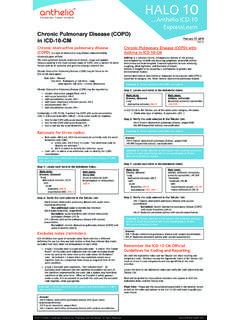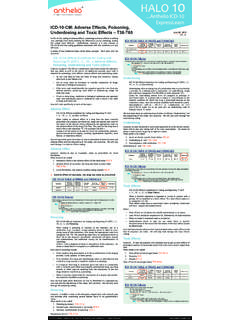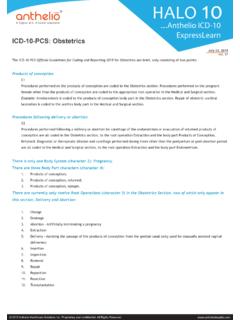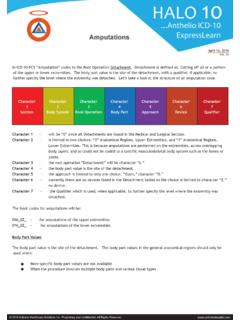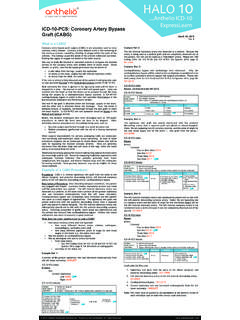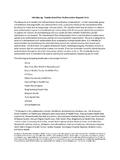Transcription of Healthcare Solutions Principal Diagnosis/First …
1 Principal Diagnosis/First listed DiagnosisICD-10-CM 2015 Anthelio Healthcare Solutions Inc. Proprietary and confidential. All Rights ICD-10 ExpressLearnLet s go back to basics as we prepare for the implementation of ICD-10-CM and review the Guidelines for designation of the Principal diagnosis for inpatient use and first listed diagnosis for outpatient DiagnosisThe definition of the Principal diagnosis as defined in the Uniform Hospital discharge Data Set (UHDDS): That condition established after study to be chiefly responsible for occasioning the admission of the patient to the hospital for care. Why is it important to make the correct selection of the Principal diagnosis ? It is significant in cost comparisons, in care analysis, and in utilization review. It is crucial for reimbursement because many third-party payers (including Medicare) base reimbursement primarily on Principal diagnosis . The Principal diagnosis is not necessarily the same diagnosis as the admitting diagnosis , but it is the diagnosis found after workup, or even after surgery, that is determined to be the reason for Principal diagnosis may, or may not, be listed first in the physician s diagnostic statement, but sequencing in the diagnostic statement or discharge summary cannot be the determining factor in establishing the Principal diagnosis .
2 Always review the entire medical record to determine the condition that should be designated as the Principal review of the ICD-10-CM Official Guidelines for Coding and Reporting FY 2016 to reestablish our knowledge of the Principal diagnosis is always helpful. The guidelines may be downloaded at: Official Guidelines for Coding and Reporting FY 2016 Section II. Selection of Principal DiagnosisA. Codes for symptoms, signs, and ill-defined conditions Codes for symptoms, signs, and ill-defined conditions from Chapter 18 are not to be used as Principal diagnosis when a related definitive diagnosis has been established. B. Two or more interrelated conditions, each potentially meeting the definition for Principal diagnosis . When there are two or more interrelated conditions (such as diseases in the same ICD-10-CM chapter or manifestations characteristically associated with a certain disease) potentially meeting the definition of Principal diagnosis , either condition may be sequenced first , unless the circumstances of the admission, the therapy provided, the Tabular List, or the Alphabetic Index indicate Two or more diagnoses that equally meet the definition for Principal diagnosis In the unusual instance when two or more diagnoses equally meet the criteria for Principal diagnosis as determined by the circumstances of admission, diagnostic workup and/or therapy provided, and the Alphabetic Index, Tabular List, or another coding guidelines does not provide sequencing direction, any one of the diagnoses may be sequenced first .
3 September 17, 2015 Vol. 21 PyramidHealthcare SolutionsHALO ICD-10 ExpressLearn 2015 Anthelio Healthcare Solutions Inc. Proprietary and confidential. All Rights Two or more comparative or contrasting conditions In those rare instances when two or more contrasting or comparative diagnoses are documented as either/or (or similar terminology), they are coded as if the diagnoses were confirmed and the diagnoses are sequenced according to the circumstances of the admission. If no further determination can be made as to which diagnosis should be Principal , either diagnosis may be sequenced first . E. A symptom(s) followed by contrasting/comparative diagnoses GUIDELINE HAS BEEN DELETED EFFECTIVE OCTOBER 1, 2014 F. Original treatment plan not carried out Sequence as the Principal diagnosis the condition, which after study occasioned the admission to the hospital, even though treatment may not have been carried out due to unforeseen circumstances. G. Complications of surgery and other medical care When the admission is for treatment of a complication resulting from surgery or other medical care, the complication code is sequenced as the Principal diagnosis .
4 If the complication is classified to the T80-T88 series and the code lacks the necessary specificity in describing the complication, an additional code for the specific complication should be Uncertain diagnosis If the diagnosis documented at the time of discharge is qualified as probable , suspected , likely , questionable , possible , or still to be ruled out , or other similar terms indicating uncertainty, code the condition as if it existed or was established. The bases for these guidelines are the diagnostic workup, arrangements for further workup or observation, and initial therapeutic approach that correspond most closely with the established diagnosis . Note: This guideline is applicable only to inpatient admissions to short-term, acute, long-term care and psychiatric hospitals. I. Admission from Observation Unit 1. Admission Following Medical Observation When a patient is admitted to an observation unit for a medical condition, which either worsens or does not improve, and is subsequently admitted as an inpatient of the same hospital for this same medical condition, the Principal diagnosis would be the medical condition which led to the hospital admission.
5 2. Admission Following Post-Operative Observation When a patient is admitted to an observation unit to monitor a condition (or complication) that develops following outpatient surgery, and then is subsequently admitted as an inpatient of the same hospital, hospitals should apply the Uniform Hospital Discharge Data Set (UHDDS) definition of Principal diagnosis as "that condition established after study to be chiefly responsible for occasioning the admission of the patient to the hospital for care."J. Admission from Outpatient Surgery When a patient receives surgery in the hospital's outpatient surgery department and is subsequently admitted for continuing inpatient care at the same hospital, the following guidelines should be followed in selecting the Principal diagnosis for the inpatient admission: If the reason for the inpatient admission is a complication, assign the complication as the Principal diagnosis . If no complication, or other condition, is documented as the reason for the inpatient admission, assign the reason for the outpatient surgery as the Principal diagnosis .
6 If the reason for the inpatient admission is another condition unrelated to the surgery, assign the unrelated condition as the Principal SolutionsSeptember 17, 2015 Vol. 21 HALO ICD-10 ExpressLearn 2015 Anthelio Healthcare Solutions Inc. Proprietary and confidential. All Rights Admissions/Encounters for Rehabilitation When the purpose for the admission/encounter is rehabilitation, sequence first the code for the condition for which the service is being performed. For example, for an admission/encounter for rehabilitation for right-sided dominant hemiplegia following a cerebrovascular infarction, report code , Hemiplegia and hemiparesis following cerebral infarction affecting right dominant side, as the first - listed or Principal diagnosis . If the condition for which the rehabilitation service is no longer present, report the appropriate aftercare code as the first - listed or Principal diagnosis .
7 For example, if a patient with severe degenerative osteoarthritis of the hip, underwent hip replacement and the current encounter/admission is for rehabilitation, report code , Aftercare following joint replacement surgery, as the first - listed or Principal listed DiagnosisThe first thing to keep in mind when coding outpatient cases is that the UHDDS definition of Principal diagnosis does not apply to outpatient contrast to inpatient coding, there is no after study component involved in the selection of the first listed diagnosis because ambulatory care visits do not permit the continued evaluation ordinarily needed to meet UHDDS criteria. If the physician does not identify a definite condition or problem at the conclusion of a visit or encounter, report the documented chief complaint as the reason for the now a review of the ICD-10-CM Official Guidelines for Coding and Reporting FY 2016 to reestablish our knowledge of the first listed diagnosis .
8 ICD-10-CM Official Guidelines for Coding and Reporting FY 2016 Section IV. Diagnostic Coding and Reporting Guidelines for Outpatient ServicesA. Selection of first - listed condition In the outpatient setting, the term first - listed diagnosis is used in lieu of Principal diagnosis . In determining the first - listed diagnosis the coding conventions of ICD-10-CM, as well as the general and disease specific guidelines take precedence over the outpatient guidelines. Diagnoses often are not established at the time of the initial encounter/visit. It may take two or more visits before the diagnosis is confirmed. The most critical rule involves beginning the search for the correct code assignment through the Alphabetic Index. Never begin searching initially in the Tabular List as this will lead to coding errors. 1. Outpatient Surgery When a patient presents for outpatient surgery (same day surgery), code the reason for the surgery as the first - listed diagnosis (reason for the encounter), even if the surgery is not performed due to a contraindication.
9 2. Observation Stay When a patient is admitted for observation for a medical condition, assign a code for the medical condition as the first - listed diagnosis . When a patient presents for outpatient surgery and develops complications requiring admission to observation, code the reason for the surgery as the first reported diagnosis (reason for the encounter), followed by codes for the complications as secondary diagnoses. PyramidHealthcare SolutionsSeptember 17, 2015 Vol. 21 HALO ICD-10 ExpressLearn 2015 Anthelio Healthcare Solutions Inc. Proprietary and confidential. All Rights SolutionsG. ICD-10-CM code for the diagnosis , condition, problem, or other reason for encounter/visit List first the ICD-10-CM code for the diagnosis , condition, problem, or other reason for encounter/visit shown in the medical record to be chiefly responsible for the services provided. List additional codes that describe any coexisting conditions.
10 In some cases the first - listed diagnosis may be a symptom when a diagnosis has not been established (confirmed) by the physician. H. Uncertain diagnosis Do not code diagnoses documented as probable , suspected, questionable, rule out, or working diagnosis or other similar terms indicating uncertainty. Rather, code the condition(s) to the highest degree of certainty for that encounter/visit, such as symptoms, signs, abnormal test results, or other reason for the visit. Please note: This differs from the coding practices used by short-term, acute care, long-term care and psychiatric hospitals. K. Patients receiving diagnostic services only For patients receiving diagnostic services only during an encounter/visit, sequence first the diagnosis , condition, problem, or other reason for encounter/visit shown in the medical record to be chiefly responsible for the outpatient services provided during the encounter/visit. Codes for other diagnoses ( , chronic conditions) may be sequenced as additional diagnoses.
